Nursing Assignment 1: Reflective Paper on Group Dynamics
VerifiedAdded on 2021/05/30
|15
|4276
|243
Report
AI Summary
This reflective paper presents a nursing student's experience with a group assignment, focusing on teamwork and team development within a healthcare context. The student reflects on the Gibbs model of reflection, evaluating personal contributions, strengths, and weaknesses within the group. The paper details the stages of team development (forming, storming, norming, performing, and adjourning), communication strategies, the importance of mutual trust and respect, coordination, cooperation, and responsibility. The student analyzes the challenges and successes of the group project, highlighting the importance of effective communication, conflict resolution, and shared goals in achieving positive outcomes. The paper concludes with insights gained from the collaborative process and its implications for future nursing practice, emphasizing the significance of teamwork in providing quality patient care in a multidisciplinary setting.
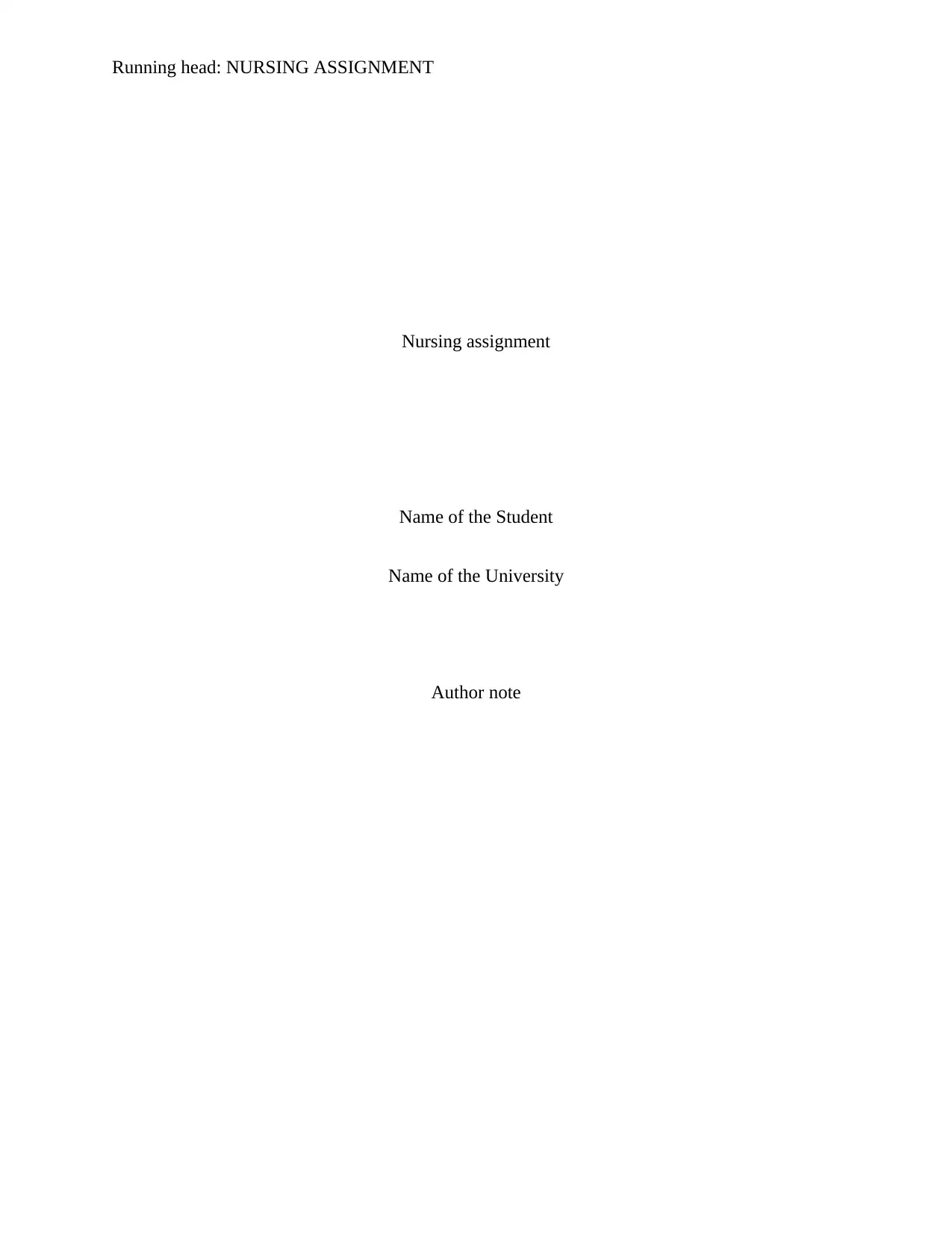
Running head: NURSING ASSIGNMENT
Nursing assignment
Name of the Student
Name of the University
Author note
Nursing assignment
Name of the Student
Name of the University
Author note
Paraphrase This Document
Need a fresh take? Get an instant paraphrase of this document with our AI Paraphraser
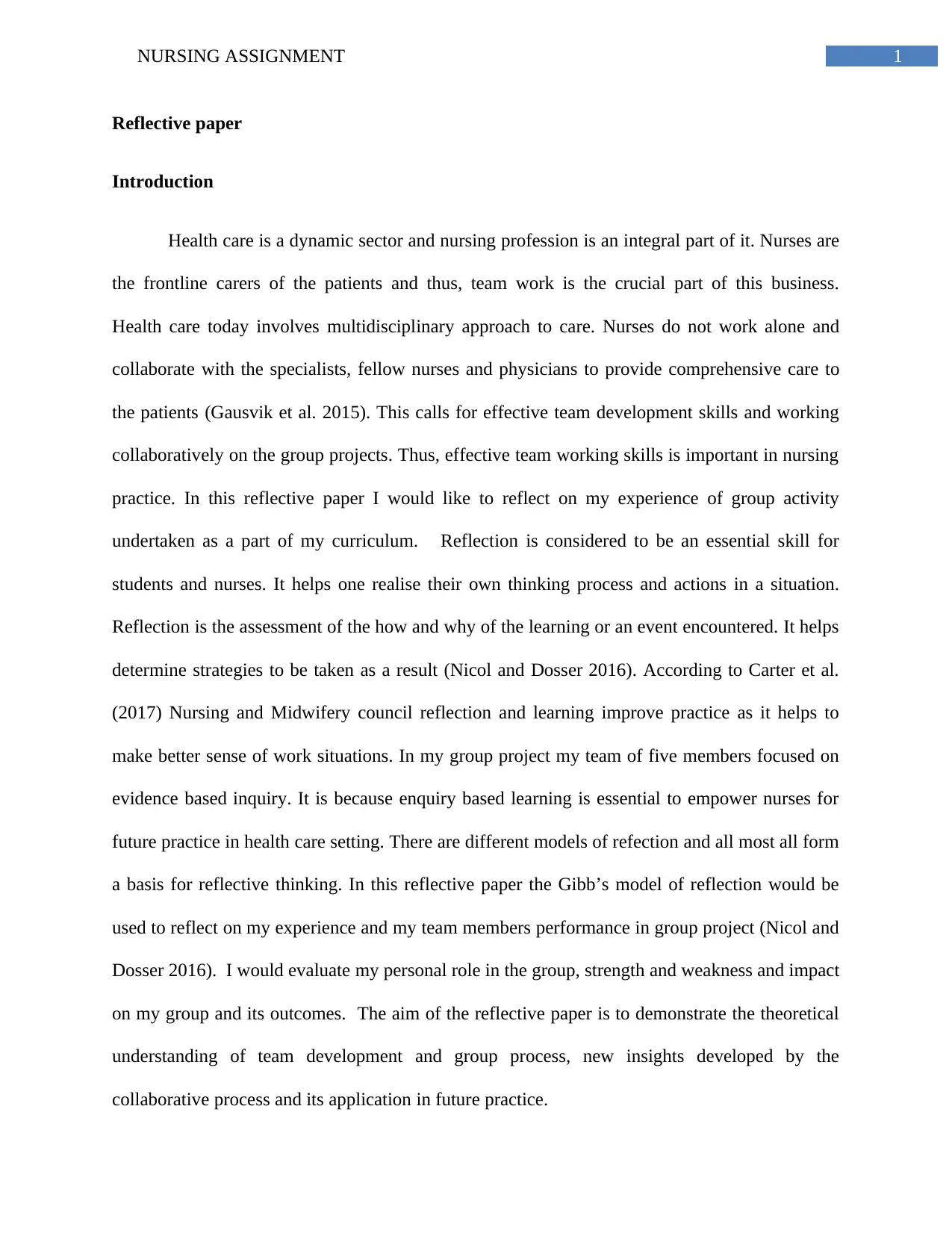
1NURSING ASSIGNMENT
Reflective paper
Introduction
Health care is a dynamic sector and nursing profession is an integral part of it. Nurses are
the frontline carers of the patients and thus, team work is the crucial part of this business.
Health care today involves multidisciplinary approach to care. Nurses do not work alone and
collaborate with the specialists, fellow nurses and physicians to provide comprehensive care to
the patients (Gausvik et al. 2015). This calls for effective team development skills and working
collaboratively on the group projects. Thus, effective team working skills is important in nursing
practice. In this reflective paper I would like to reflect on my experience of group activity
undertaken as a part of my curriculum. Reflection is considered to be an essential skill for
students and nurses. It helps one realise their own thinking process and actions in a situation.
Reflection is the assessment of the how and why of the learning or an event encountered. It helps
determine strategies to be taken as a result (Nicol and Dosser 2016). According to Carter et al.
(2017) Nursing and Midwifery council reflection and learning improve practice as it helps to
make better sense of work situations. In my group project my team of five members focused on
evidence based inquiry. It is because enquiry based learning is essential to empower nurses for
future practice in health care setting. There are different models of refection and all most all form
a basis for reflective thinking. In this reflective paper the Gibb’s model of reflection would be
used to reflect on my experience and my team members performance in group project (Nicol and
Dosser 2016). I would evaluate my personal role in the group, strength and weakness and impact
on my group and its outcomes. The aim of the reflective paper is to demonstrate the theoretical
understanding of team development and group process, new insights developed by the
collaborative process and its application in future practice.
Reflective paper
Introduction
Health care is a dynamic sector and nursing profession is an integral part of it. Nurses are
the frontline carers of the patients and thus, team work is the crucial part of this business.
Health care today involves multidisciplinary approach to care. Nurses do not work alone and
collaborate with the specialists, fellow nurses and physicians to provide comprehensive care to
the patients (Gausvik et al. 2015). This calls for effective team development skills and working
collaboratively on the group projects. Thus, effective team working skills is important in nursing
practice. In this reflective paper I would like to reflect on my experience of group activity
undertaken as a part of my curriculum. Reflection is considered to be an essential skill for
students and nurses. It helps one realise their own thinking process and actions in a situation.
Reflection is the assessment of the how and why of the learning or an event encountered. It helps
determine strategies to be taken as a result (Nicol and Dosser 2016). According to Carter et al.
(2017) Nursing and Midwifery council reflection and learning improve practice as it helps to
make better sense of work situations. In my group project my team of five members focused on
evidence based inquiry. It is because enquiry based learning is essential to empower nurses for
future practice in health care setting. There are different models of refection and all most all form
a basis for reflective thinking. In this reflective paper the Gibb’s model of reflection would be
used to reflect on my experience and my team members performance in group project (Nicol and
Dosser 2016). I would evaluate my personal role in the group, strength and weakness and impact
on my group and its outcomes. The aim of the reflective paper is to demonstrate the theoretical
understanding of team development and group process, new insights developed by the
collaborative process and its application in future practice.
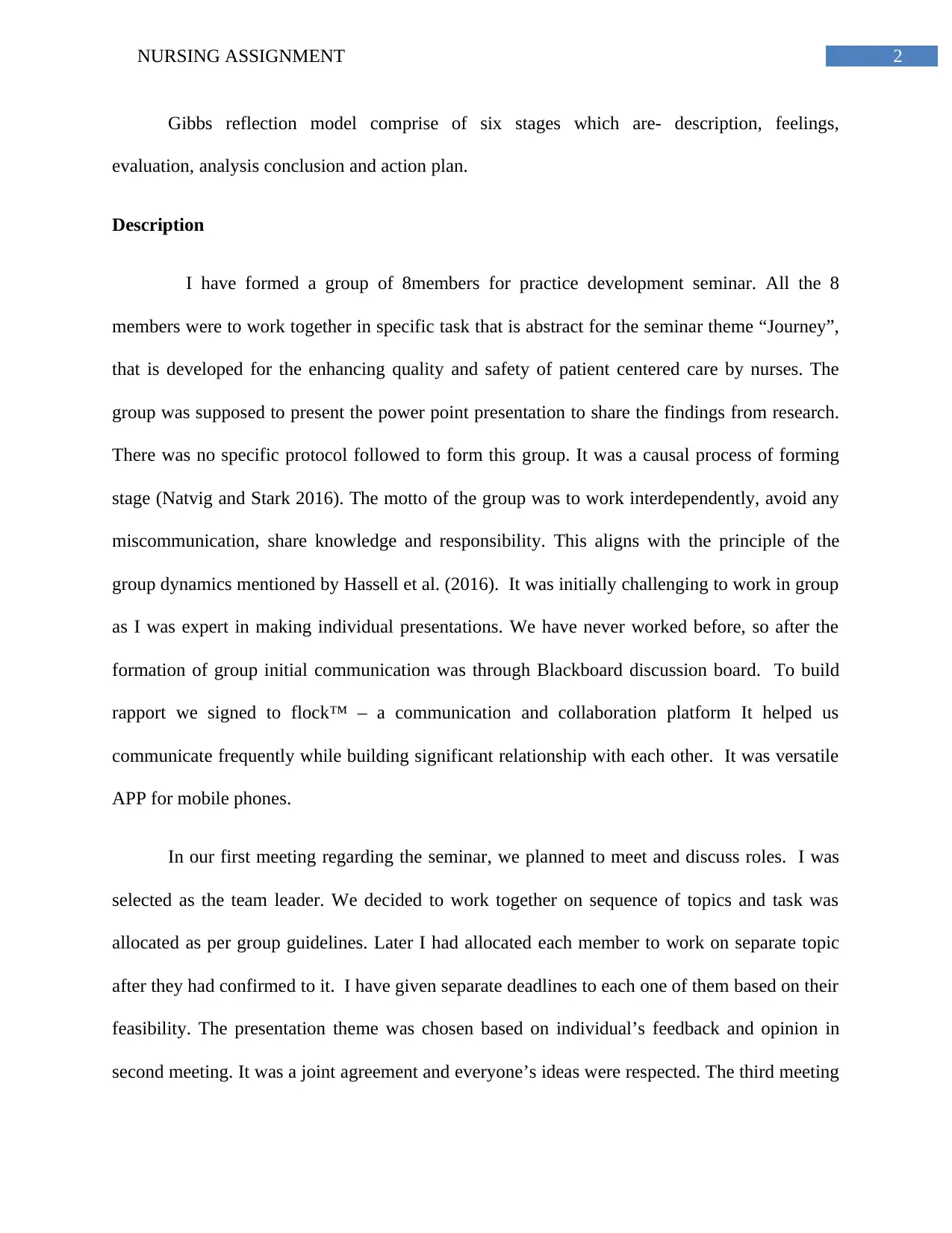
2NURSING ASSIGNMENT
Gibbs reflection model comprise of six stages which are- description, feelings,
evaluation, analysis conclusion and action plan.
Description
I have formed a group of 8members for practice development seminar. All the 8
members were to work together in specific task that is abstract for the seminar theme “Journey”,
that is developed for the enhancing quality and safety of patient centered care by nurses. The
group was supposed to present the power point presentation to share the findings from research.
There was no specific protocol followed to form this group. It was a causal process of forming
stage (Natvig and Stark 2016). The motto of the group was to work interdependently, avoid any
miscommunication, share knowledge and responsibility. This aligns with the principle of the
group dynamics mentioned by Hassell et al. (2016). It was initially challenging to work in group
as I was expert in making individual presentations. We have never worked before, so after the
formation of group initial communication was through Blackboard discussion board. To build
rapport we signed to flock™ – a communication and collaboration platform It helped us
communicate frequently while building significant relationship with each other. It was versatile
APP for mobile phones.
In our first meeting regarding the seminar, we planned to meet and discuss roles. I was
selected as the team leader. We decided to work together on sequence of topics and task was
allocated as per group guidelines. Later I had allocated each member to work on separate topic
after they had confirmed to it. I have given separate deadlines to each one of them based on their
feasibility. The presentation theme was chosen based on individual’s feedback and opinion in
second meeting. It was a joint agreement and everyone’s ideas were respected. The third meeting
Gibbs reflection model comprise of six stages which are- description, feelings,
evaluation, analysis conclusion and action plan.
Description
I have formed a group of 8members for practice development seminar. All the 8
members were to work together in specific task that is abstract for the seminar theme “Journey”,
that is developed for the enhancing quality and safety of patient centered care by nurses. The
group was supposed to present the power point presentation to share the findings from research.
There was no specific protocol followed to form this group. It was a causal process of forming
stage (Natvig and Stark 2016). The motto of the group was to work interdependently, avoid any
miscommunication, share knowledge and responsibility. This aligns with the principle of the
group dynamics mentioned by Hassell et al. (2016). It was initially challenging to work in group
as I was expert in making individual presentations. We have never worked before, so after the
formation of group initial communication was through Blackboard discussion board. To build
rapport we signed to flock™ – a communication and collaboration platform It helped us
communicate frequently while building significant relationship with each other. It was versatile
APP for mobile phones.
In our first meeting regarding the seminar, we planned to meet and discuss roles. I was
selected as the team leader. We decided to work together on sequence of topics and task was
allocated as per group guidelines. Later I had allocated each member to work on separate topic
after they had confirmed to it. I have given separate deadlines to each one of them based on their
feasibility. The presentation theme was chosen based on individual’s feedback and opinion in
second meeting. It was a joint agreement and everyone’s ideas were respected. The third meeting
⊘ This is a preview!⊘
Do you want full access?
Subscribe today to unlock all pages.

Trusted by 1+ million students worldwide
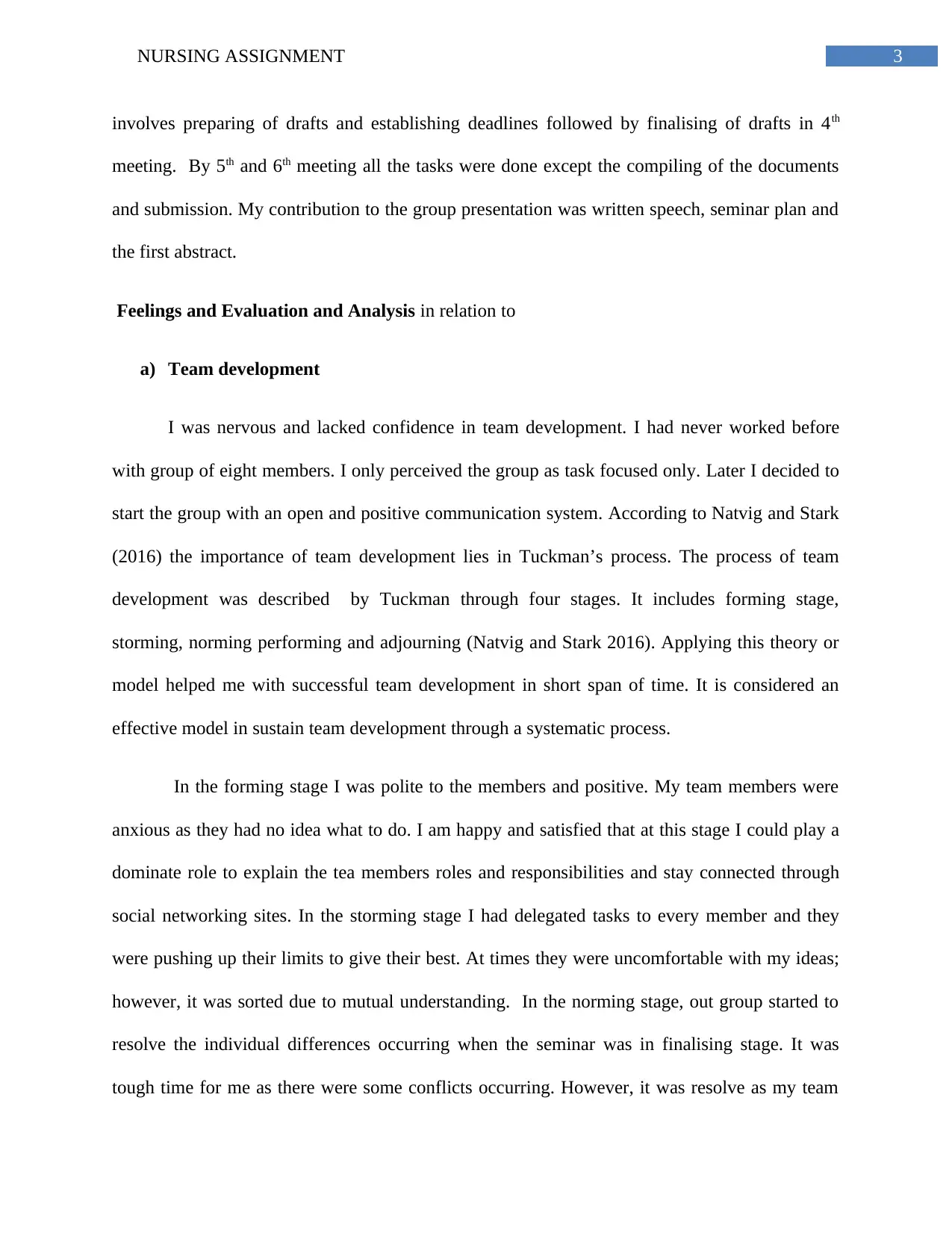
3NURSING ASSIGNMENT
involves preparing of drafts and establishing deadlines followed by finalising of drafts in 4th
meeting. By 5th and 6th meeting all the tasks were done except the compiling of the documents
and submission. My contribution to the group presentation was written speech, seminar plan and
the first abstract.
Feelings and Evaluation and Analysis in relation to
a) Team development
I was nervous and lacked confidence in team development. I had never worked before
with group of eight members. I only perceived the group as task focused only. Later I decided to
start the group with an open and positive communication system. According to Natvig and Stark
(2016) the importance of team development lies in Tuckman’s process. The process of team
development was described by Tuckman through four stages. It includes forming stage,
storming, norming performing and adjourning (Natvig and Stark 2016). Applying this theory or
model helped me with successful team development in short span of time. It is considered an
effective model in sustain team development through a systematic process.
In the forming stage I was polite to the members and positive. My team members were
anxious as they had no idea what to do. I am happy and satisfied that at this stage I could play a
dominate role to explain the tea members roles and responsibilities and stay connected through
social networking sites. In the storming stage I had delegated tasks to every member and they
were pushing up their limits to give their best. At times they were uncomfortable with my ideas;
however, it was sorted due to mutual understanding. In the norming stage, out group started to
resolve the individual differences occurring when the seminar was in finalising stage. It was
tough time for me as there were some conflicts occurring. However, it was resolve as my team
involves preparing of drafts and establishing deadlines followed by finalising of drafts in 4th
meeting. By 5th and 6th meeting all the tasks were done except the compiling of the documents
and submission. My contribution to the group presentation was written speech, seminar plan and
the first abstract.
Feelings and Evaluation and Analysis in relation to
a) Team development
I was nervous and lacked confidence in team development. I had never worked before
with group of eight members. I only perceived the group as task focused only. Later I decided to
start the group with an open and positive communication system. According to Natvig and Stark
(2016) the importance of team development lies in Tuckman’s process. The process of team
development was described by Tuckman through four stages. It includes forming stage,
storming, norming performing and adjourning (Natvig and Stark 2016). Applying this theory or
model helped me with successful team development in short span of time. It is considered an
effective model in sustain team development through a systematic process.
In the forming stage I was polite to the members and positive. My team members were
anxious as they had no idea what to do. I am happy and satisfied that at this stage I could play a
dominate role to explain the tea members roles and responsibilities and stay connected through
social networking sites. In the storming stage I had delegated tasks to every member and they
were pushing up their limits to give their best. At times they were uncomfortable with my ideas;
however, it was sorted due to mutual understanding. In the norming stage, out group started to
resolve the individual differences occurring when the seminar was in finalising stage. It was
tough time for me as there were some conflicts occurring. However, it was resolve as my team
Paraphrase This Document
Need a fresh take? Get an instant paraphrase of this document with our AI Paraphraser
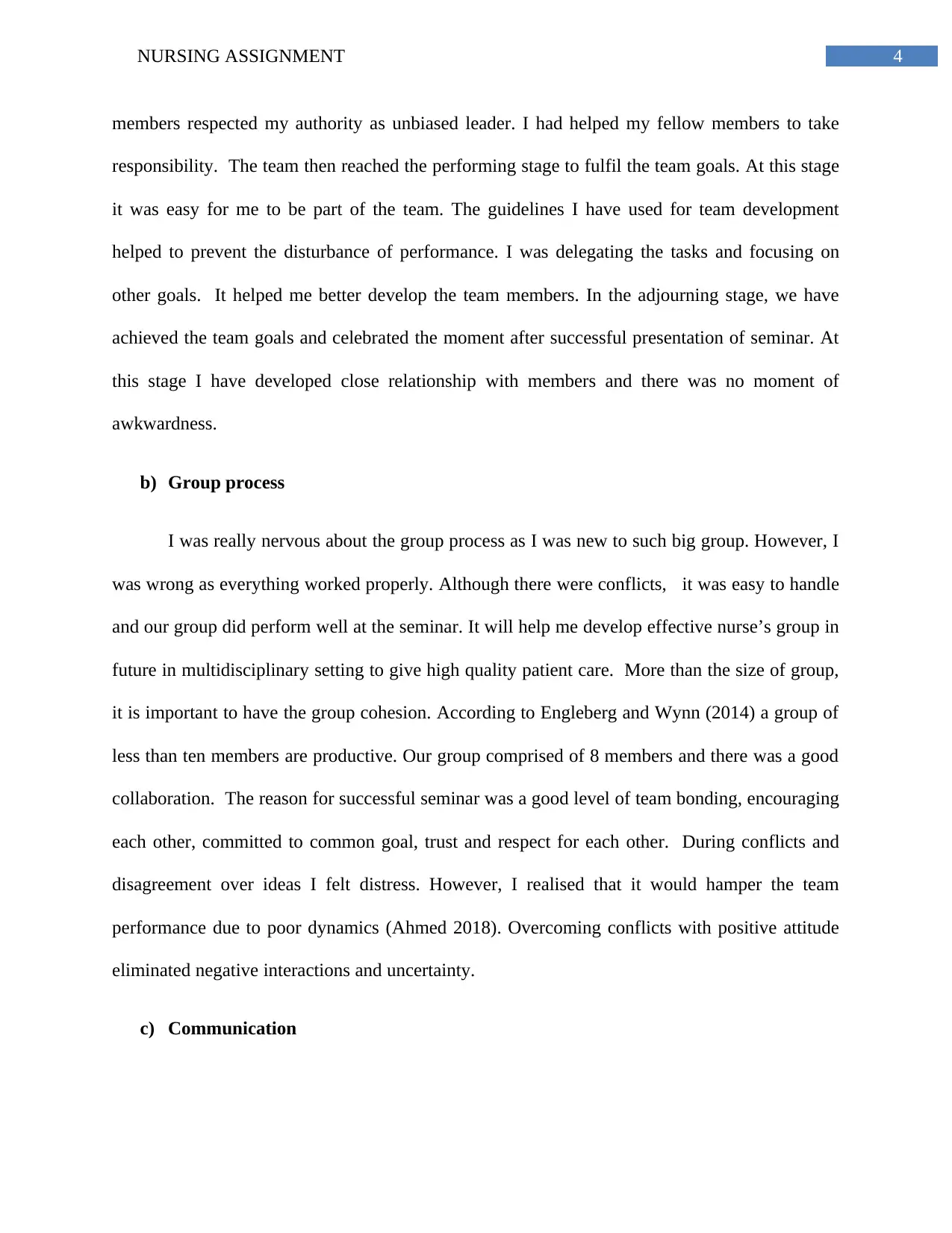
4NURSING ASSIGNMENT
members respected my authority as unbiased leader. I had helped my fellow members to take
responsibility. The team then reached the performing stage to fulfil the team goals. At this stage
it was easy for me to be part of the team. The guidelines I have used for team development
helped to prevent the disturbance of performance. I was delegating the tasks and focusing on
other goals. It helped me better develop the team members. In the adjourning stage, we have
achieved the team goals and celebrated the moment after successful presentation of seminar. At
this stage I have developed close relationship with members and there was no moment of
awkwardness.
b) Group process
I was really nervous about the group process as I was new to such big group. However, I
was wrong as everything worked properly. Although there were conflicts, it was easy to handle
and our group did perform well at the seminar. It will help me develop effective nurse’s group in
future in multidisciplinary setting to give high quality patient care. More than the size of group,
it is important to have the group cohesion. According to Engleberg and Wynn (2014) a group of
less than ten members are productive. Our group comprised of 8 members and there was a good
collaboration. The reason for successful seminar was a good level of team bonding, encouraging
each other, committed to common goal, trust and respect for each other. During conflicts and
disagreement over ideas I felt distress. However, I realised that it would hamper the team
performance due to poor dynamics (Ahmed 2018). Overcoming conflicts with positive attitude
eliminated negative interactions and uncertainty.
c) Communication
members respected my authority as unbiased leader. I had helped my fellow members to take
responsibility. The team then reached the performing stage to fulfil the team goals. At this stage
it was easy for me to be part of the team. The guidelines I have used for team development
helped to prevent the disturbance of performance. I was delegating the tasks and focusing on
other goals. It helped me better develop the team members. In the adjourning stage, we have
achieved the team goals and celebrated the moment after successful presentation of seminar. At
this stage I have developed close relationship with members and there was no moment of
awkwardness.
b) Group process
I was really nervous about the group process as I was new to such big group. However, I
was wrong as everything worked properly. Although there were conflicts, it was easy to handle
and our group did perform well at the seminar. It will help me develop effective nurse’s group in
future in multidisciplinary setting to give high quality patient care. More than the size of group,
it is important to have the group cohesion. According to Engleberg and Wynn (2014) a group of
less than ten members are productive. Our group comprised of 8 members and there was a good
collaboration. The reason for successful seminar was a good level of team bonding, encouraging
each other, committed to common goal, trust and respect for each other. During conflicts and
disagreement over ideas I felt distress. However, I realised that it would hamper the team
performance due to poor dynamics (Ahmed 2018). Overcoming conflicts with positive attitude
eliminated negative interactions and uncertainty.
c) Communication
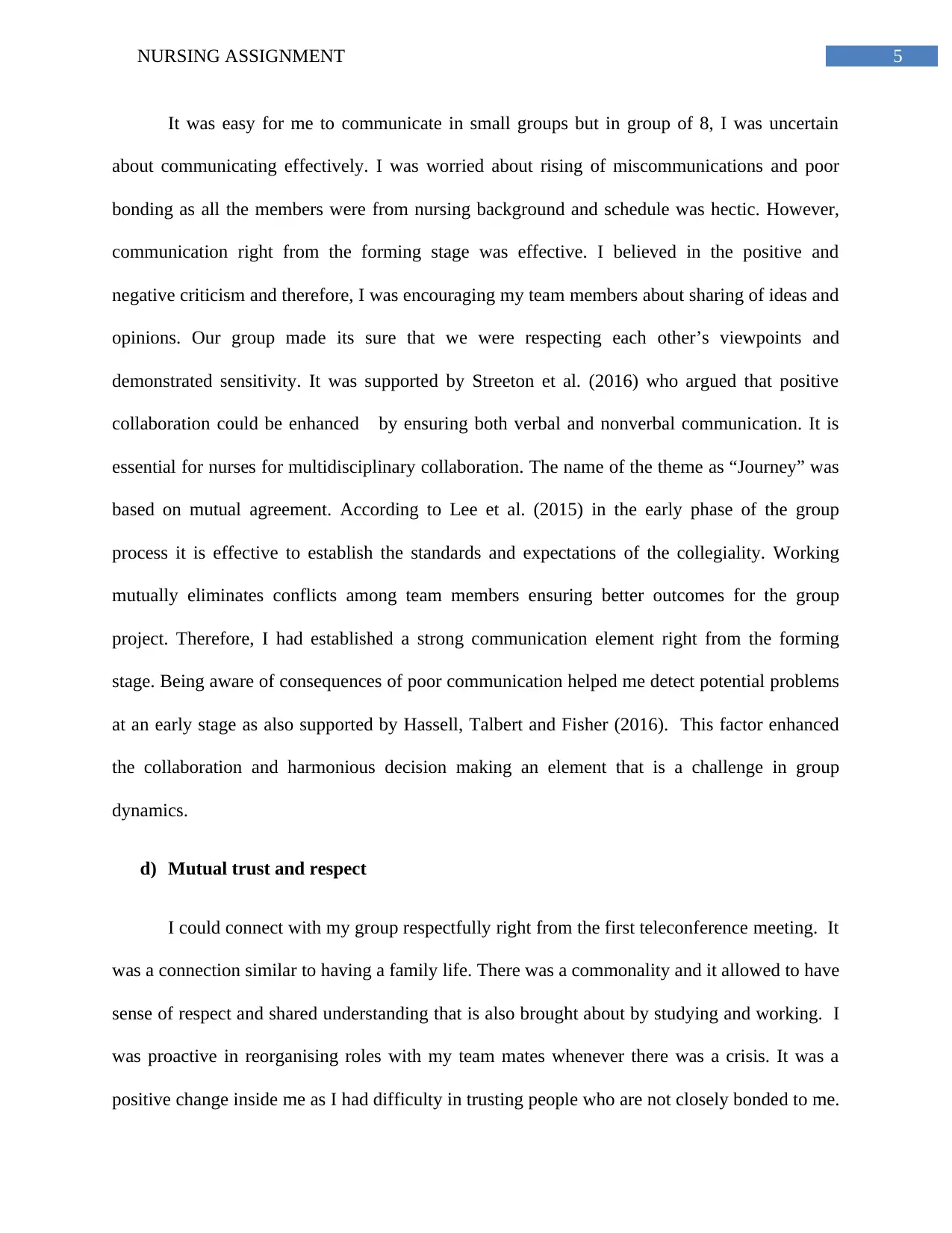
5NURSING ASSIGNMENT
It was easy for me to communicate in small groups but in group of 8, I was uncertain
about communicating effectively. I was worried about rising of miscommunications and poor
bonding as all the members were from nursing background and schedule was hectic. However,
communication right from the forming stage was effective. I believed in the positive and
negative criticism and therefore, I was encouraging my team members about sharing of ideas and
opinions. Our group made its sure that we were respecting each other’s viewpoints and
demonstrated sensitivity. It was supported by Streeton et al. (2016) who argued that positive
collaboration could be enhanced by ensuring both verbal and nonverbal communication. It is
essential for nurses for multidisciplinary collaboration. The name of the theme as “Journey” was
based on mutual agreement. According to Lee et al. (2015) in the early phase of the group
process it is effective to establish the standards and expectations of the collegiality. Working
mutually eliminates conflicts among team members ensuring better outcomes for the group
project. Therefore, I had established a strong communication element right from the forming
stage. Being aware of consequences of poor communication helped me detect potential problems
at an early stage as also supported by Hassell, Talbert and Fisher (2016). This factor enhanced
the collaboration and harmonious decision making an element that is a challenge in group
dynamics.
d) Mutual trust and respect
I could connect with my group respectfully right from the first teleconference meeting. It
was a connection similar to having a family life. There was a commonality and it allowed to have
sense of respect and shared understanding that is also brought about by studying and working. I
was proactive in reorganising roles with my team mates whenever there was a crisis. It was a
positive change inside me as I had difficulty in trusting people who are not closely bonded to me.
It was easy for me to communicate in small groups but in group of 8, I was uncertain
about communicating effectively. I was worried about rising of miscommunications and poor
bonding as all the members were from nursing background and schedule was hectic. However,
communication right from the forming stage was effective. I believed in the positive and
negative criticism and therefore, I was encouraging my team members about sharing of ideas and
opinions. Our group made its sure that we were respecting each other’s viewpoints and
demonstrated sensitivity. It was supported by Streeton et al. (2016) who argued that positive
collaboration could be enhanced by ensuring both verbal and nonverbal communication. It is
essential for nurses for multidisciplinary collaboration. The name of the theme as “Journey” was
based on mutual agreement. According to Lee et al. (2015) in the early phase of the group
process it is effective to establish the standards and expectations of the collegiality. Working
mutually eliminates conflicts among team members ensuring better outcomes for the group
project. Therefore, I had established a strong communication element right from the forming
stage. Being aware of consequences of poor communication helped me detect potential problems
at an early stage as also supported by Hassell, Talbert and Fisher (2016). This factor enhanced
the collaboration and harmonious decision making an element that is a challenge in group
dynamics.
d) Mutual trust and respect
I could connect with my group respectfully right from the first teleconference meeting. It
was a connection similar to having a family life. There was a commonality and it allowed to have
sense of respect and shared understanding that is also brought about by studying and working. I
was proactive in reorganising roles with my team mates whenever there was a crisis. It was a
positive change inside me as I had difficulty in trusting people who are not closely bonded to me.
⊘ This is a preview!⊘
Do you want full access?
Subscribe today to unlock all pages.

Trusted by 1+ million students worldwide
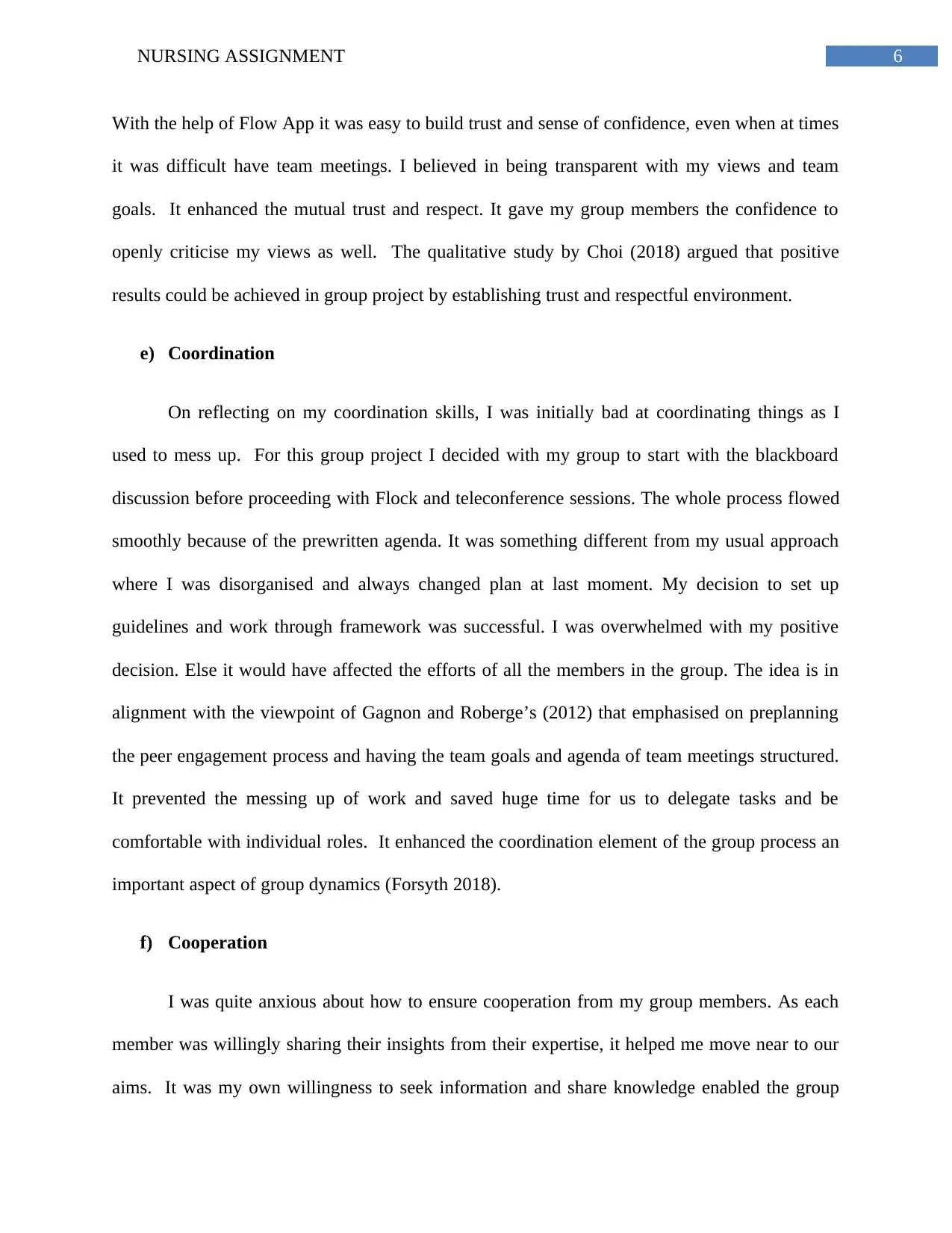
6NURSING ASSIGNMENT
With the help of Flow App it was easy to build trust and sense of confidence, even when at times
it was difficult have team meetings. I believed in being transparent with my views and team
goals. It enhanced the mutual trust and respect. It gave my group members the confidence to
openly criticise my views as well. The qualitative study by Choi (2018) argued that positive
results could be achieved in group project by establishing trust and respectful environment.
e) Coordination
On reflecting on my coordination skills, I was initially bad at coordinating things as I
used to mess up. For this group project I decided with my group to start with the blackboard
discussion before proceeding with Flock and teleconference sessions. The whole process flowed
smoothly because of the prewritten agenda. It was something different from my usual approach
where I was disorganised and always changed plan at last moment. My decision to set up
guidelines and work through framework was successful. I was overwhelmed with my positive
decision. Else it would have affected the efforts of all the members in the group. The idea is in
alignment with the viewpoint of Gagnon and Roberge’s (2012) that emphasised on preplanning
the peer engagement process and having the team goals and agenda of team meetings structured.
It prevented the messing up of work and saved huge time for us to delegate tasks and be
comfortable with individual roles. It enhanced the coordination element of the group process an
important aspect of group dynamics (Forsyth 2018).
f) Cooperation
I was quite anxious about how to ensure cooperation from my group members. As each
member was willingly sharing their insights from their expertise, it helped me move near to our
aims. It was my own willingness to seek information and share knowledge enabled the group
With the help of Flow App it was easy to build trust and sense of confidence, even when at times
it was difficult have team meetings. I believed in being transparent with my views and team
goals. It enhanced the mutual trust and respect. It gave my group members the confidence to
openly criticise my views as well. The qualitative study by Choi (2018) argued that positive
results could be achieved in group project by establishing trust and respectful environment.
e) Coordination
On reflecting on my coordination skills, I was initially bad at coordinating things as I
used to mess up. For this group project I decided with my group to start with the blackboard
discussion before proceeding with Flock and teleconference sessions. The whole process flowed
smoothly because of the prewritten agenda. It was something different from my usual approach
where I was disorganised and always changed plan at last moment. My decision to set up
guidelines and work through framework was successful. I was overwhelmed with my positive
decision. Else it would have affected the efforts of all the members in the group. The idea is in
alignment with the viewpoint of Gagnon and Roberge’s (2012) that emphasised on preplanning
the peer engagement process and having the team goals and agenda of team meetings structured.
It prevented the messing up of work and saved huge time for us to delegate tasks and be
comfortable with individual roles. It enhanced the coordination element of the group process an
important aspect of group dynamics (Forsyth 2018).
f) Cooperation
I was quite anxious about how to ensure cooperation from my group members. As each
member was willingly sharing their insights from their expertise, it helped me move near to our
aims. It was my own willingness to seek information and share knowledge enabled the group
Paraphrase This Document
Need a fresh take? Get an instant paraphrase of this document with our AI Paraphraser
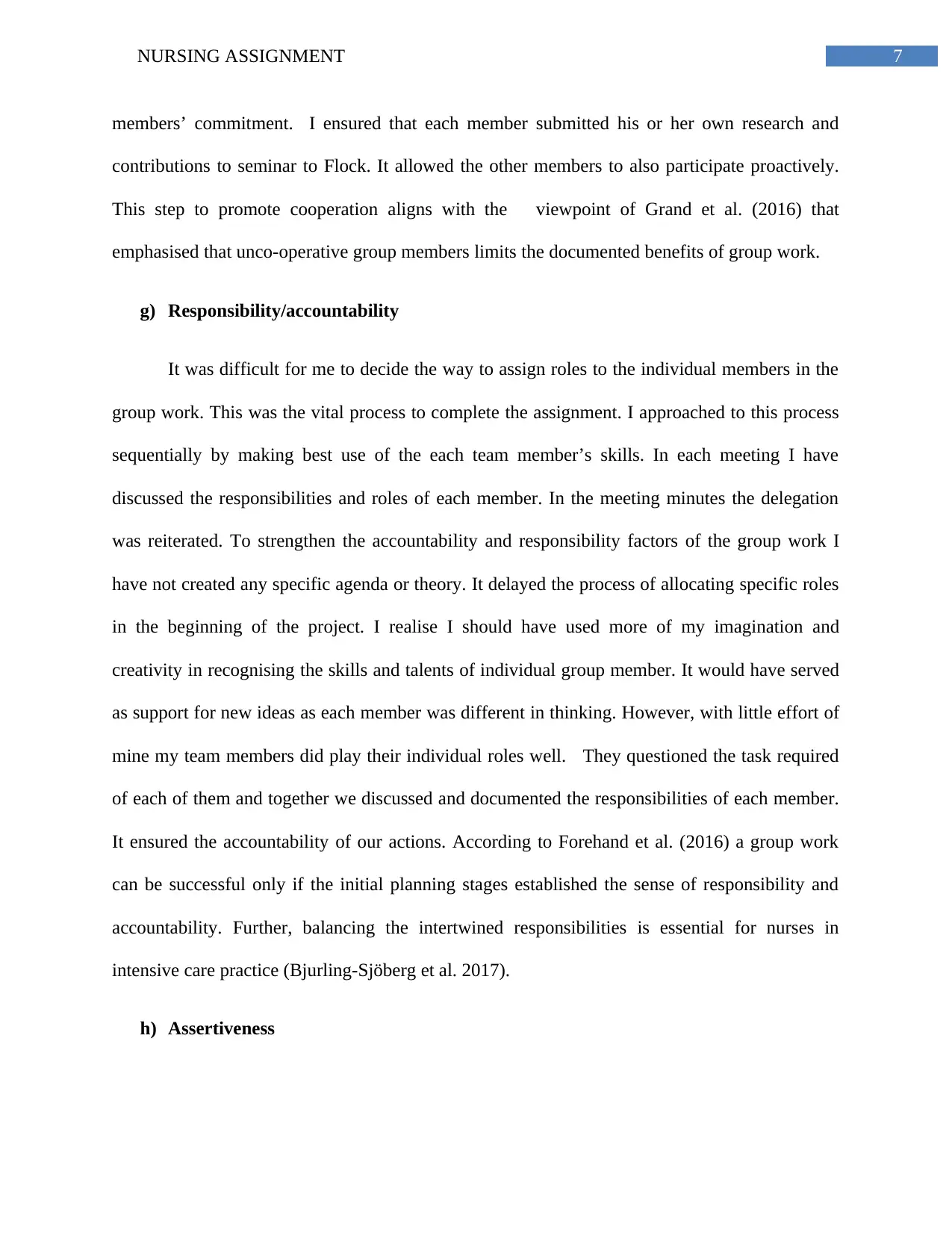
7NURSING ASSIGNMENT
members’ commitment. I ensured that each member submitted his or her own research and
contributions to seminar to Flock. It allowed the other members to also participate proactively.
This step to promote cooperation aligns with the viewpoint of Grand et al. (2016) that
emphasised that unco-operative group members limits the documented benefits of group work.
g) Responsibility/accountability
It was difficult for me to decide the way to assign roles to the individual members in the
group work. This was the vital process to complete the assignment. I approached to this process
sequentially by making best use of the each team member’s skills. In each meeting I have
discussed the responsibilities and roles of each member. In the meeting minutes the delegation
was reiterated. To strengthen the accountability and responsibility factors of the group work I
have not created any specific agenda or theory. It delayed the process of allocating specific roles
in the beginning of the project. I realise I should have used more of my imagination and
creativity in recognising the skills and talents of individual group member. It would have served
as support for new ideas as each member was different in thinking. However, with little effort of
mine my team members did play their individual roles well. They questioned the task required
of each of them and together we discussed and documented the responsibilities of each member.
It ensured the accountability of our actions. According to Forehand et al. (2016) a group work
can be successful only if the initial planning stages established the sense of responsibility and
accountability. Further, balancing the intertwined responsibilities is essential for nurses in
intensive care practice (Bjurling-Sjöberg et al. 2017).
h) Assertiveness
members’ commitment. I ensured that each member submitted his or her own research and
contributions to seminar to Flock. It allowed the other members to also participate proactively.
This step to promote cooperation aligns with the viewpoint of Grand et al. (2016) that
emphasised that unco-operative group members limits the documented benefits of group work.
g) Responsibility/accountability
It was difficult for me to decide the way to assign roles to the individual members in the
group work. This was the vital process to complete the assignment. I approached to this process
sequentially by making best use of the each team member’s skills. In each meeting I have
discussed the responsibilities and roles of each member. In the meeting minutes the delegation
was reiterated. To strengthen the accountability and responsibility factors of the group work I
have not created any specific agenda or theory. It delayed the process of allocating specific roles
in the beginning of the project. I realise I should have used more of my imagination and
creativity in recognising the skills and talents of individual group member. It would have served
as support for new ideas as each member was different in thinking. However, with little effort of
mine my team members did play their individual roles well. They questioned the task required
of each of them and together we discussed and documented the responsibilities of each member.
It ensured the accountability of our actions. According to Forehand et al. (2016) a group work
can be successful only if the initial planning stages established the sense of responsibility and
accountability. Further, balancing the intertwined responsibilities is essential for nurses in
intensive care practice (Bjurling-Sjöberg et al. 2017).
h) Assertiveness
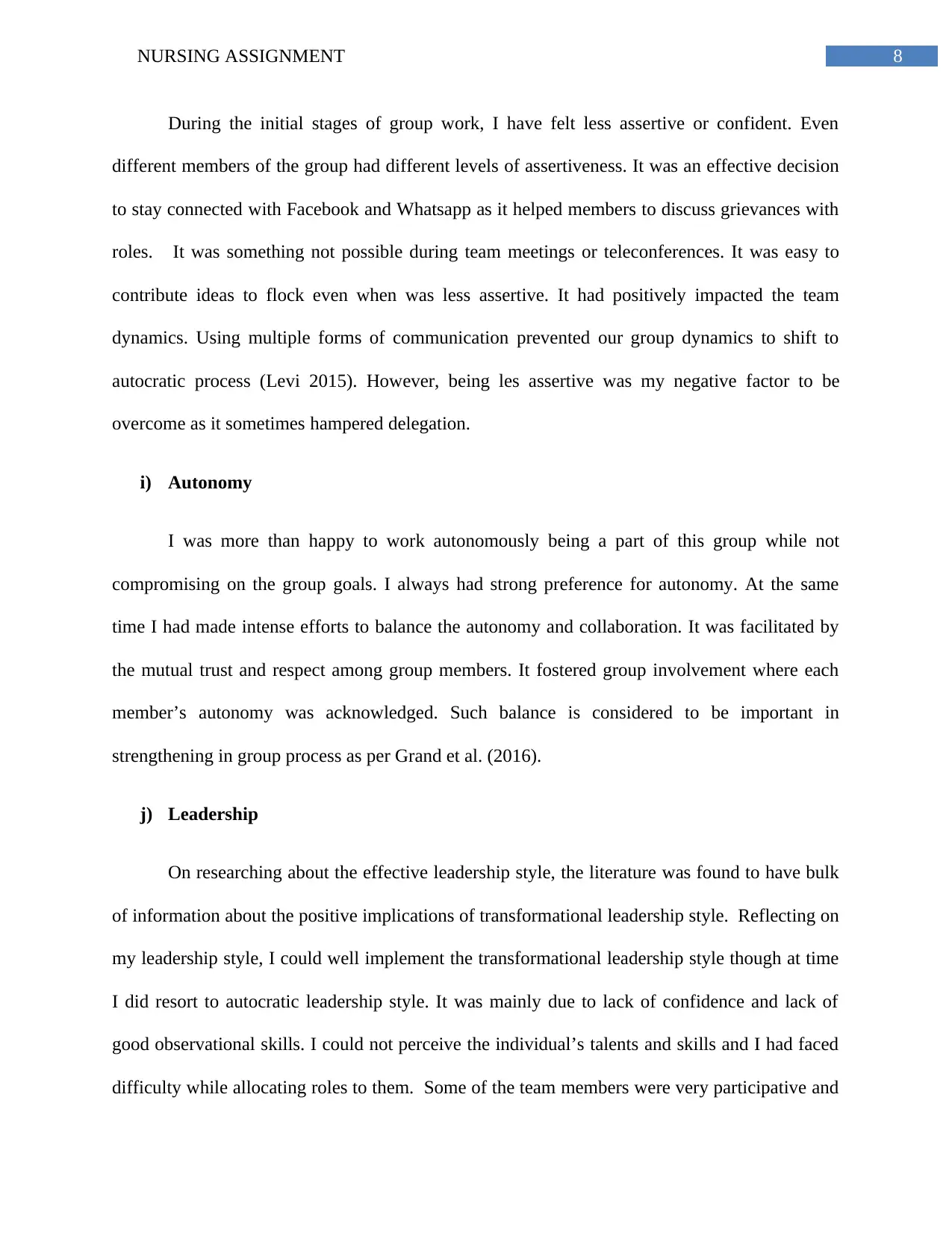
8NURSING ASSIGNMENT
During the initial stages of group work, I have felt less assertive or confident. Even
different members of the group had different levels of assertiveness. It was an effective decision
to stay connected with Facebook and Whatsapp as it helped members to discuss grievances with
roles. It was something not possible during team meetings or teleconferences. It was easy to
contribute ideas to flock even when was less assertive. It had positively impacted the team
dynamics. Using multiple forms of communication prevented our group dynamics to shift to
autocratic process (Levi 2015). However, being les assertive was my negative factor to be
overcome as it sometimes hampered delegation.
i) Autonomy
I was more than happy to work autonomously being a part of this group while not
compromising on the group goals. I always had strong preference for autonomy. At the same
time I had made intense efforts to balance the autonomy and collaboration. It was facilitated by
the mutual trust and respect among group members. It fostered group involvement where each
member’s autonomy was acknowledged. Such balance is considered to be important in
strengthening in group process as per Grand et al. (2016).
j) Leadership
On researching about the effective leadership style, the literature was found to have bulk
of information about the positive implications of transformational leadership style. Reflecting on
my leadership style, I could well implement the transformational leadership style though at time
I did resort to autocratic leadership style. It was mainly due to lack of confidence and lack of
good observational skills. I could not perceive the individual’s talents and skills and I had faced
difficulty while allocating roles to them. Some of the team members were very participative and
During the initial stages of group work, I have felt less assertive or confident. Even
different members of the group had different levels of assertiveness. It was an effective decision
to stay connected with Facebook and Whatsapp as it helped members to discuss grievances with
roles. It was something not possible during team meetings or teleconferences. It was easy to
contribute ideas to flock even when was less assertive. It had positively impacted the team
dynamics. Using multiple forms of communication prevented our group dynamics to shift to
autocratic process (Levi 2015). However, being les assertive was my negative factor to be
overcome as it sometimes hampered delegation.
i) Autonomy
I was more than happy to work autonomously being a part of this group while not
compromising on the group goals. I always had strong preference for autonomy. At the same
time I had made intense efforts to balance the autonomy and collaboration. It was facilitated by
the mutual trust and respect among group members. It fostered group involvement where each
member’s autonomy was acknowledged. Such balance is considered to be important in
strengthening in group process as per Grand et al. (2016).
j) Leadership
On researching about the effective leadership style, the literature was found to have bulk
of information about the positive implications of transformational leadership style. Reflecting on
my leadership style, I could well implement the transformational leadership style though at time
I did resort to autocratic leadership style. It was mainly due to lack of confidence and lack of
good observational skills. I could not perceive the individual’s talents and skills and I had faced
difficulty while allocating roles to them. Some of the team members were very participative and
⊘ This is a preview!⊘
Do you want full access?
Subscribe today to unlock all pages.

Trusted by 1+ million students worldwide
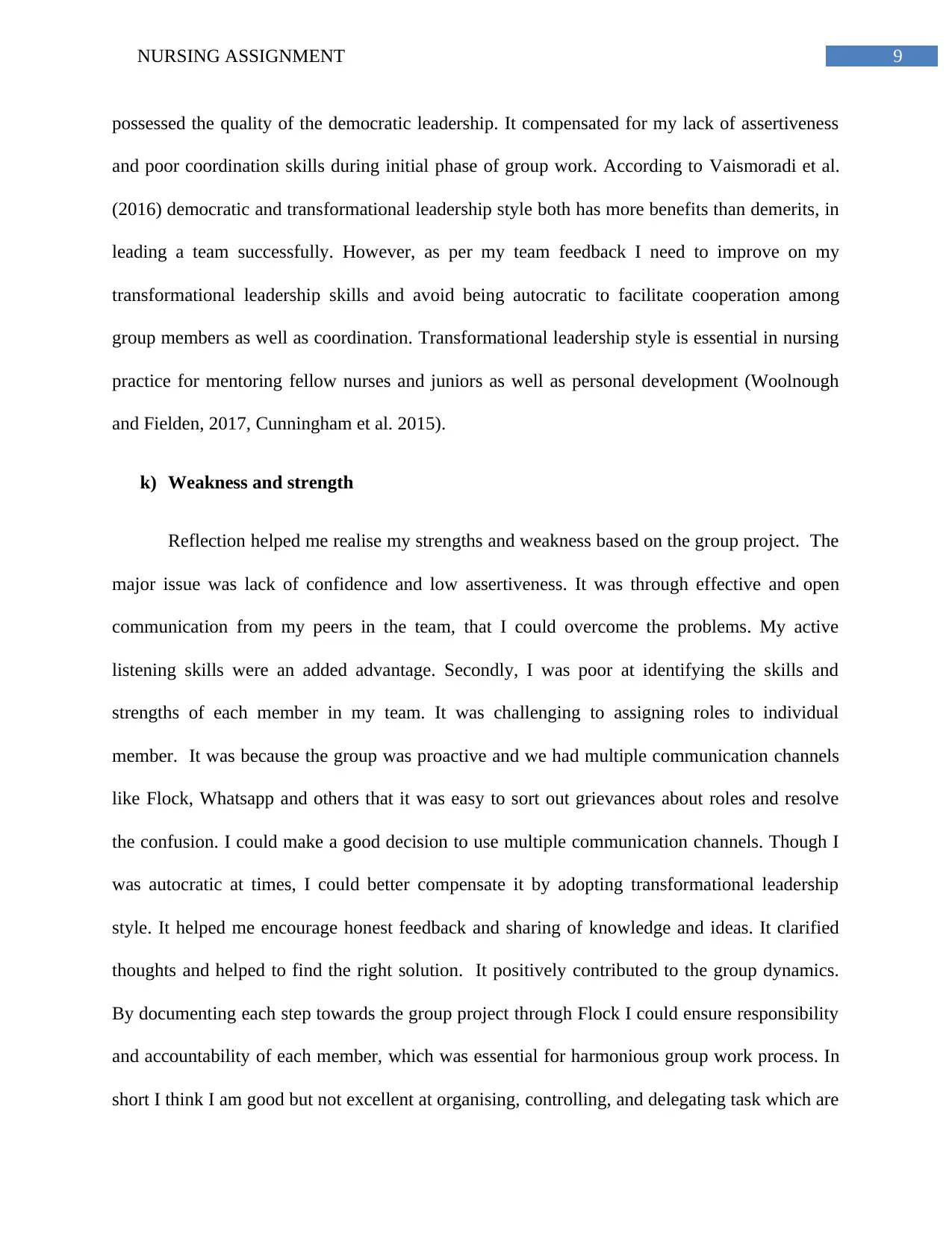
9NURSING ASSIGNMENT
possessed the quality of the democratic leadership. It compensated for my lack of assertiveness
and poor coordination skills during initial phase of group work. According to Vaismoradi et al.
(2016) democratic and transformational leadership style both has more benefits than demerits, in
leading a team successfully. However, as per my team feedback I need to improve on my
transformational leadership skills and avoid being autocratic to facilitate cooperation among
group members as well as coordination. Transformational leadership style is essential in nursing
practice for mentoring fellow nurses and juniors as well as personal development (Woolnough
and Fielden, 2017, Cunningham et al. 2015).
k) Weakness and strength
Reflection helped me realise my strengths and weakness based on the group project. The
major issue was lack of confidence and low assertiveness. It was through effective and open
communication from my peers in the team, that I could overcome the problems. My active
listening skills were an added advantage. Secondly, I was poor at identifying the skills and
strengths of each member in my team. It was challenging to assigning roles to individual
member. It was because the group was proactive and we had multiple communication channels
like Flock, Whatsapp and others that it was easy to sort out grievances about roles and resolve
the confusion. I could make a good decision to use multiple communication channels. Though I
was autocratic at times, I could better compensate it by adopting transformational leadership
style. It helped me encourage honest feedback and sharing of knowledge and ideas. It clarified
thoughts and helped to find the right solution. It positively contributed to the group dynamics.
By documenting each step towards the group project through Flock I could ensure responsibility
and accountability of each member, which was essential for harmonious group work process. In
short I think I am good but not excellent at organising, controlling, and delegating task which are
possessed the quality of the democratic leadership. It compensated for my lack of assertiveness
and poor coordination skills during initial phase of group work. According to Vaismoradi et al.
(2016) democratic and transformational leadership style both has more benefits than demerits, in
leading a team successfully. However, as per my team feedback I need to improve on my
transformational leadership skills and avoid being autocratic to facilitate cooperation among
group members as well as coordination. Transformational leadership style is essential in nursing
practice for mentoring fellow nurses and juniors as well as personal development (Woolnough
and Fielden, 2017, Cunningham et al. 2015).
k) Weakness and strength
Reflection helped me realise my strengths and weakness based on the group project. The
major issue was lack of confidence and low assertiveness. It was through effective and open
communication from my peers in the team, that I could overcome the problems. My active
listening skills were an added advantage. Secondly, I was poor at identifying the skills and
strengths of each member in my team. It was challenging to assigning roles to individual
member. It was because the group was proactive and we had multiple communication channels
like Flock, Whatsapp and others that it was easy to sort out grievances about roles and resolve
the confusion. I could make a good decision to use multiple communication channels. Though I
was autocratic at times, I could better compensate it by adopting transformational leadership
style. It helped me encourage honest feedback and sharing of knowledge and ideas. It clarified
thoughts and helped to find the right solution. It positively contributed to the group dynamics.
By documenting each step towards the group project through Flock I could ensure responsibility
and accountability of each member, which was essential for harmonious group work process. In
short I think I am good but not excellent at organising, controlling, and delegating task which are
Paraphrase This Document
Need a fresh take? Get an instant paraphrase of this document with our AI Paraphraser
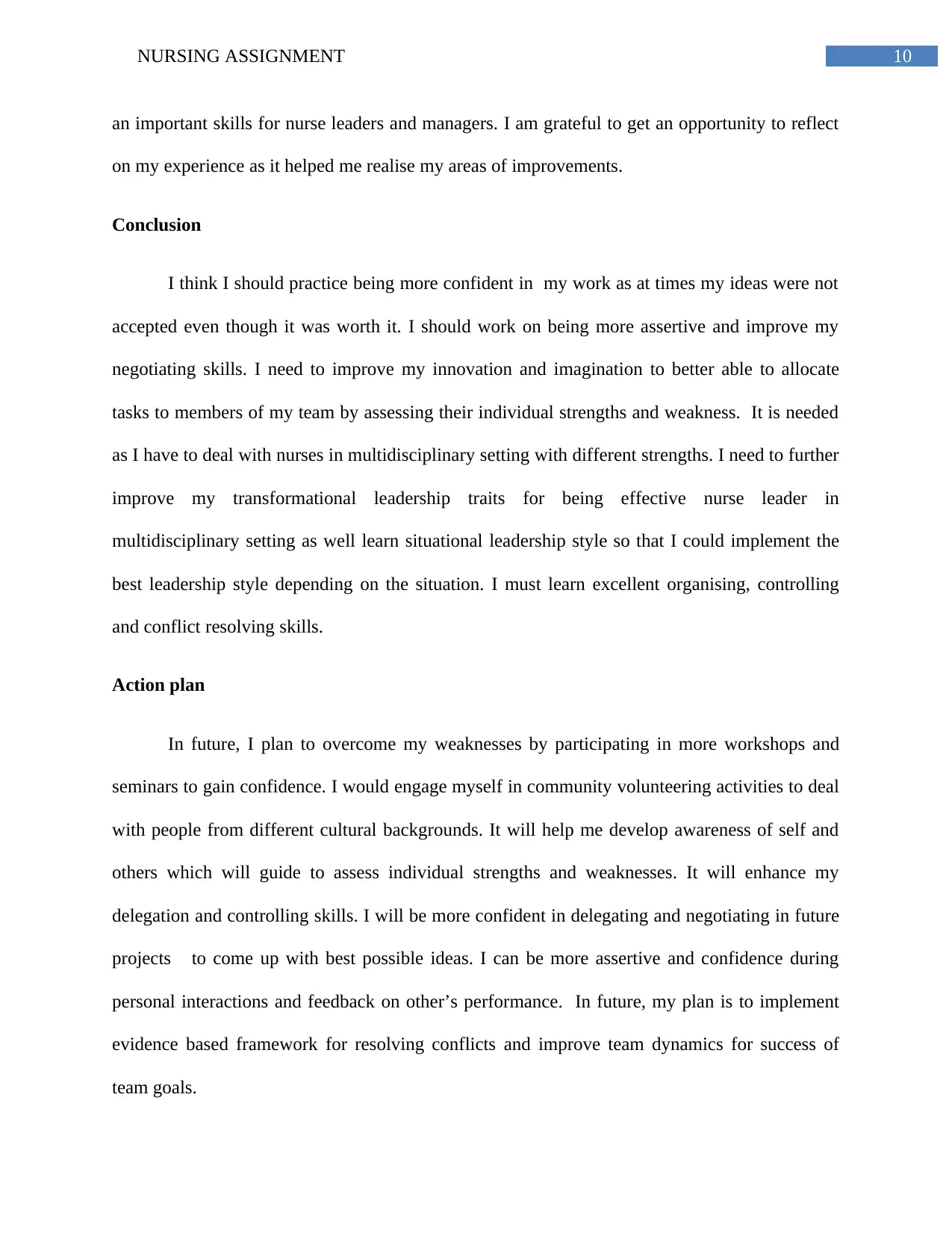
10NURSING ASSIGNMENT
an important skills for nurse leaders and managers. I am grateful to get an opportunity to reflect
on my experience as it helped me realise my areas of improvements.
Conclusion
I think I should practice being more confident in my work as at times my ideas were not
accepted even though it was worth it. I should work on being more assertive and improve my
negotiating skills. I need to improve my innovation and imagination to better able to allocate
tasks to members of my team by assessing their individual strengths and weakness. It is needed
as I have to deal with nurses in multidisciplinary setting with different strengths. I need to further
improve my transformational leadership traits for being effective nurse leader in
multidisciplinary setting as well learn situational leadership style so that I could implement the
best leadership style depending on the situation. I must learn excellent organising, controlling
and conflict resolving skills.
Action plan
In future, I plan to overcome my weaknesses by participating in more workshops and
seminars to gain confidence. I would engage myself in community volunteering activities to deal
with people from different cultural backgrounds. It will help me develop awareness of self and
others which will guide to assess individual strengths and weaknesses. It will enhance my
delegation and controlling skills. I will be more confident in delegating and negotiating in future
projects to come up with best possible ideas. I can be more assertive and confidence during
personal interactions and feedback on other’s performance. In future, my plan is to implement
evidence based framework for resolving conflicts and improve team dynamics for success of
team goals.
an important skills for nurse leaders and managers. I am grateful to get an opportunity to reflect
on my experience as it helped me realise my areas of improvements.
Conclusion
I think I should practice being more confident in my work as at times my ideas were not
accepted even though it was worth it. I should work on being more assertive and improve my
negotiating skills. I need to improve my innovation and imagination to better able to allocate
tasks to members of my team by assessing their individual strengths and weakness. It is needed
as I have to deal with nurses in multidisciplinary setting with different strengths. I need to further
improve my transformational leadership traits for being effective nurse leader in
multidisciplinary setting as well learn situational leadership style so that I could implement the
best leadership style depending on the situation. I must learn excellent organising, controlling
and conflict resolving skills.
Action plan
In future, I plan to overcome my weaknesses by participating in more workshops and
seminars to gain confidence. I would engage myself in community volunteering activities to deal
with people from different cultural backgrounds. It will help me develop awareness of self and
others which will guide to assess individual strengths and weaknesses. It will enhance my
delegation and controlling skills. I will be more confident in delegating and negotiating in future
projects to come up with best possible ideas. I can be more assertive and confidence during
personal interactions and feedback on other’s performance. In future, my plan is to implement
evidence based framework for resolving conflicts and improve team dynamics for success of
team goals.
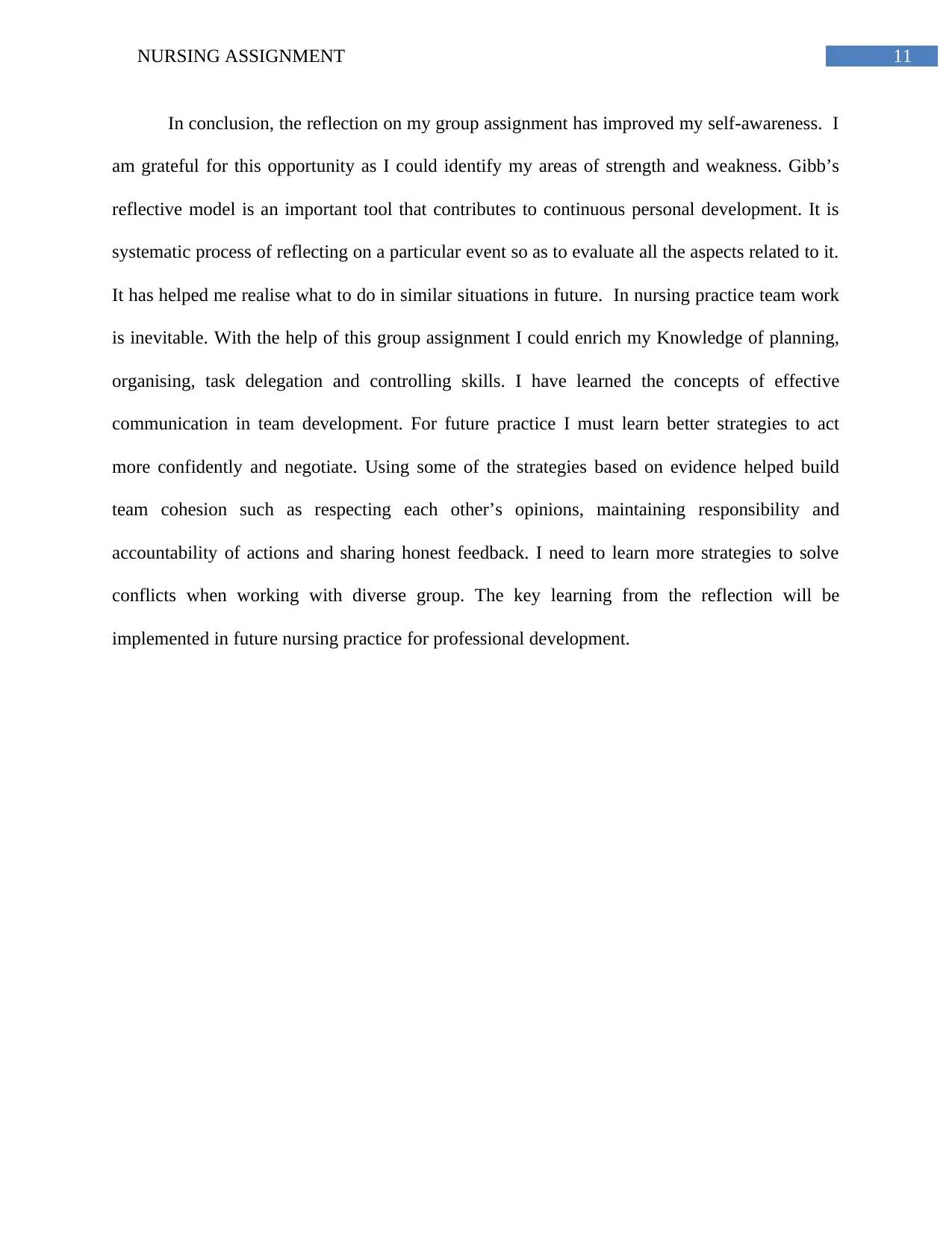
11NURSING ASSIGNMENT
In conclusion, the reflection on my group assignment has improved my self-awareness. I
am grateful for this opportunity as I could identify my areas of strength and weakness. Gibb’s
reflective model is an important tool that contributes to continuous personal development. It is
systematic process of reflecting on a particular event so as to evaluate all the aspects related to it.
It has helped me realise what to do in similar situations in future. In nursing practice team work
is inevitable. With the help of this group assignment I could enrich my Knowledge of planning,
organising, task delegation and controlling skills. I have learned the concepts of effective
communication in team development. For future practice I must learn better strategies to act
more confidently and negotiate. Using some of the strategies based on evidence helped build
team cohesion such as respecting each other’s opinions, maintaining responsibility and
accountability of actions and sharing honest feedback. I need to learn more strategies to solve
conflicts when working with diverse group. The key learning from the reflection will be
implemented in future nursing practice for professional development.
In conclusion, the reflection on my group assignment has improved my self-awareness. I
am grateful for this opportunity as I could identify my areas of strength and weakness. Gibb’s
reflective model is an important tool that contributes to continuous personal development. It is
systematic process of reflecting on a particular event so as to evaluate all the aspects related to it.
It has helped me realise what to do in similar situations in future. In nursing practice team work
is inevitable. With the help of this group assignment I could enrich my Knowledge of planning,
organising, task delegation and controlling skills. I have learned the concepts of effective
communication in team development. For future practice I must learn better strategies to act
more confidently and negotiate. Using some of the strategies based on evidence helped build
team cohesion such as respecting each other’s opinions, maintaining responsibility and
accountability of actions and sharing honest feedback. I need to learn more strategies to solve
conflicts when working with diverse group. The key learning from the reflection will be
implemented in future nursing practice for professional development.
⊘ This is a preview!⊘
Do you want full access?
Subscribe today to unlock all pages.

Trusted by 1+ million students worldwide
1 out of 15
Related Documents
Your All-in-One AI-Powered Toolkit for Academic Success.
+13062052269
info@desklib.com
Available 24*7 on WhatsApp / Email
![[object Object]](/_next/static/media/star-bottom.7253800d.svg)
Unlock your academic potential
Copyright © 2020–2025 A2Z Services. All Rights Reserved. Developed and managed by ZUCOL.





